20.6: Gene Expression- Applied Example (Part 1)
- Last updated
- Save as PDF
- Page ID
- 101415

- Marjorie Hanneman, Walter Suza, Donald Lee, & Patricia Hain
- Iowa State University via Iowa State University Digital Press
Learning Objectives
At the completion of this lesson you should be able to:
- Define the roles of DNA and proteins in cell development and metabolism
- Determine the amino acid sequence of a protein given the nucleotide sequence of a gene.
- Describe the roles that the promoter, coding region and termination sequence of a gene play in gene expression.
- Recognize the differences between the structure of proteins, amino acids, genes, and nucleotides.
- Draw the process of gene expression and include the following in your drawing. Gene, RNA polymerase, promoter, coding region, termination sequence, cell, nucleus, cytoplasm, mRNA, tRNA, ribosome, anticodon, codon, amino acid, protein, peptide bond.
You have learned this fundamental biology fact: genes provide the information to instruct cells how to build specific proteins and these proteins control cell development and metabolism. Some biologists refer to this fact as the “Central Dogma”. We prefer to refer to this process as gene expression. This lesson will integrate this biology fundamental with some gene expression examples. These examples emphasize an additional fundamental biology idea that life is a continuous cycle. In order for living cells to live, they require the genes, RNAs, and proteins that came from prior existing living cells.
Example #1: Gene Expression of the Plant Acetolactate Synthase Enzyme Gene
We have selected this gene because the protein the gene encodes is the target site for several types of herbicides and thus is an important example in agriculture. The gene also illustrates an important circle of life concept. All living things need amino acids to build proteins and some living things need proteins to build amino acids.
The ALS gene is not found in animals but is found in plants and bacteria. Plants and bacteria are able make all their own amino acids. Animals must consume a subset of the 20 amino acids (see Lesson on Translation) in their diet. One gene all plants and bacteria must have to live encodes the enzyme acetolactate synthase (ALS). ALS enzyme allows plants to make their own supply of three of the 20 amino acids; leucine, isoleucine, and valine. The ALS protein is an enzyme and is needed to catalyze a reaction in the chemical pathway that makes these three amino acids. Let us detail the information transfer steps needed for gene expression: use the genetic code of DNA sequences in the gene to encode the amino acid sequence of the ALS enzyme.
Three parts of the Gene and a Two-Step Process
The ALS gene consists of several thousand nucleotides of DNA and like all genes has three main parts, the promoter, coding region, and termination sequences (Figure 1, gene sequence abbreviated for demonstration).

Each part of the ALS gene plays a role in controlling gene expression and this is a two-part process. The promoter is the on/off switch of the gene, the coding region determines the amino acids sequence of the protein that will get made and the termination sequence signals where the gene information ends. The DNA sequence that makes up a gene is a part of a much larger chromosome of continuous DNA. The gene sequence is organized to make an RNA (ribonucleic acid) copy of the gene’s nucleotide sequence to serve as a mobile message for protein building. RNA building is called transcription because DNA nucleotides encode RNA nucleotides.
Step 1: Transcription: control from the promoter and termination sequence
The promoter’s role is to selectively turn on the ALS gene in cells that will need the ALS enzyme. The promoter accomplishes this by its specific nucleotide sequences that react with regulatory molecules in the cell. We will discuss the regulation of gene expression in more detail later. What cells in a plant will need the ALS enzyme? All cells that are making proteins. This will be all cells in the plant at some stage of development. Therefore, the ALS gene has a promoter sequence that allows the gene to be turned on in all types of cells. When the ALS gene is turned on, transcription can take place. Like most chemistry in the cell, enzymes will be needed for gene expression. RNA polymerase is the transcription enzyme (Figure 2) which will bind to the DNA sequences in the ALS promoter and interact with one strand of the gene (the coding strand).
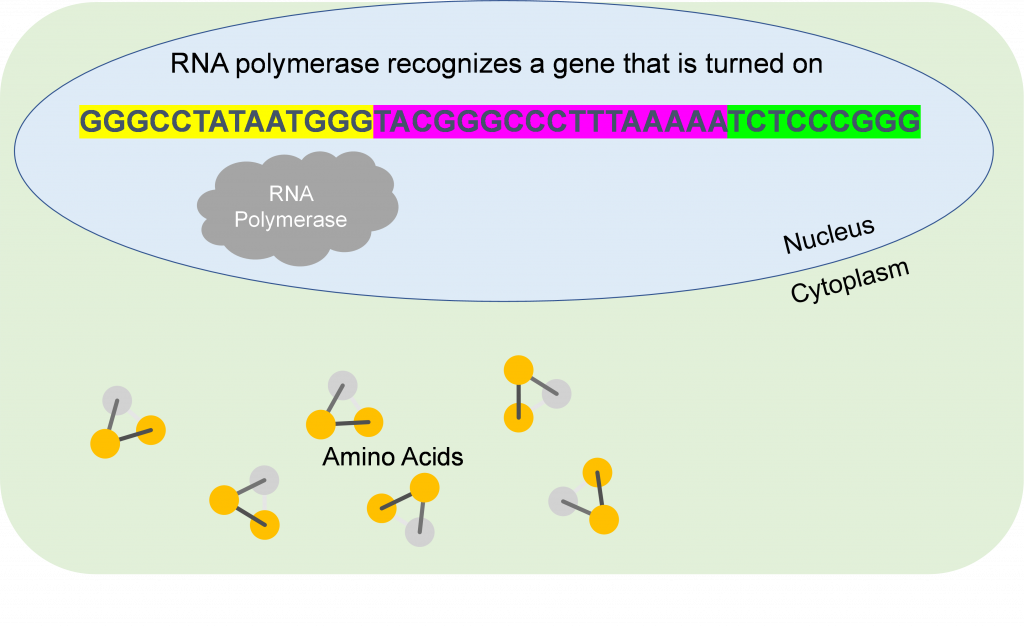
RNA polymerase works by moving along the gene promoter until it encounters a series of A and T nucleotides called the TATA box (Figure 3). The TATA box signals RNA polymerase that it has reached the end of the promoter. Now the enzyme has the “green light” to read the coding strand DNA and make RNA. The procedure works much like DNA replication. RNA polymerase will read the DNA in a 3’ to 5’ direction and build the RNA 5’ to 3’. Unlike DNA replication though, only one DNA strand is read and the transcription process must end once the RNA polymerase reaches the end of the ALS gene. If RNA polymerase kept going along that strand of the DNA making up the chromosome, other genes that are on the same chromosome might be expressed in the wrong cells or at the wrong times.
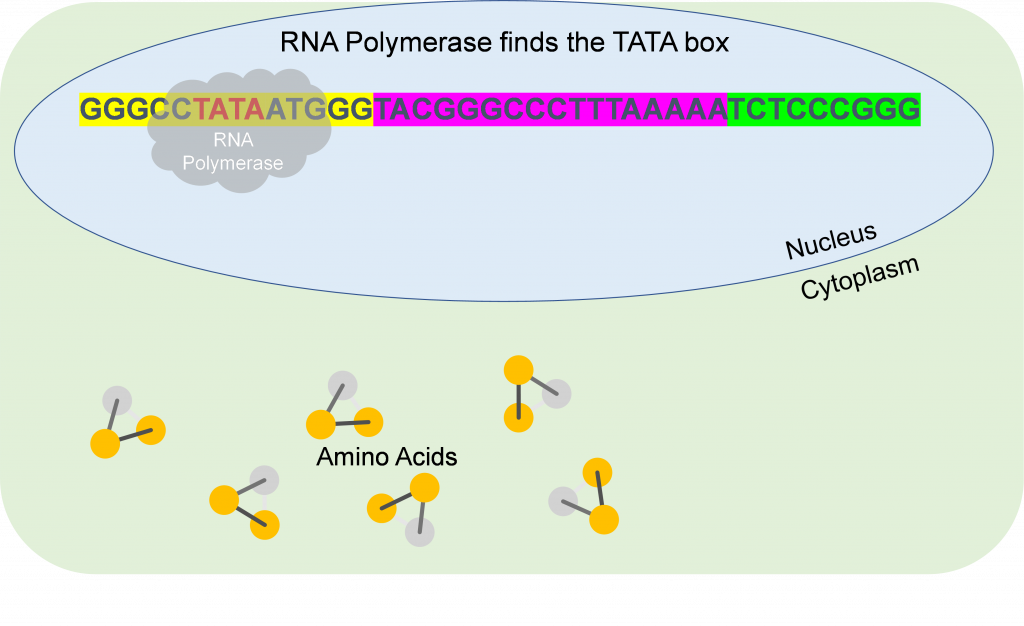
How is the RNA polymerase signaled that it has reached the end of the gene? That is the role of a termination sequence in the gene (Figure 4). The termination sequences signal the end of the gene. One transcription termination strategy will be described here. The nucleotides that make up the termination sequence of the ALS gene could be ordered to form a palindrome. This means that the nucleotides being placed in the RNA can fold back on themselves and form a hairpin loop (Figure 5).
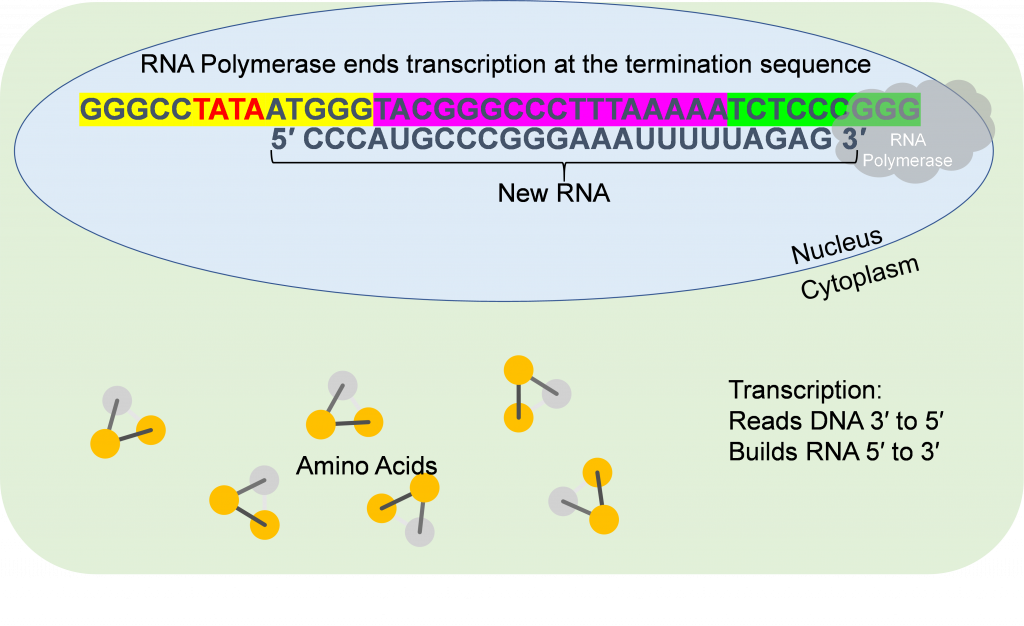
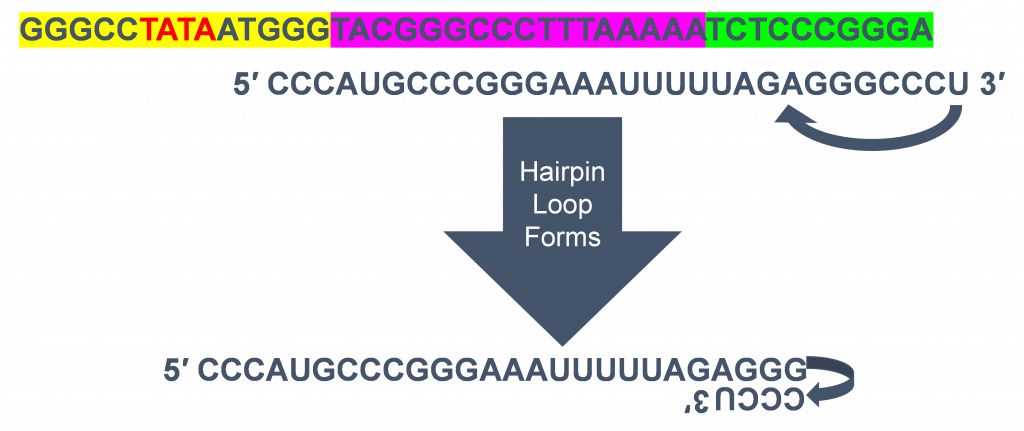
While no geneticist has actually viewed this hairpin loop formation in action, it is believed that the hairpin formation snaps the RNA polymerase off the DNA coding strand and releases the RNA message. Transcription of an RNA that has the coding region information is now completed. Each time an RNA polymerase goes through the process, one copy of the RNA is made by reading the DNA template. The type of RNA made from transcription of the ALS gene is called a messenger RNA or mRNA for short. Some genes can encode transfer RNA (tRNA) or ribosomal RNA (rRNA). These RNA molecules have special roles in the next part of gene expression called translation. Once an mRNA is transcribed, some modifications will occur in the nucleus. We will describe some of the post-transcriptional processes later. For now, let’s follow the ALS mRNA onto the translation step of gene expression.
Watch this video from UNL for more information about the Transcription process
Step 2: Translation: reading the code to make proteins
The translation process requires a conversion of information from a chain of nucleotides in RNA to a chain of amino acids in protein. The translation term was coined based on the idea that we are converting to a new molecular language at this stage of gene expression. The conversion of information in translation is a little more complex than transcription and requires several biomolecules to interact and work together (Figure 7). We will describe the ribosomes and tRNAs molecules first and then describe how they work together to translate a mRNA.
- tRNA: The ‘t’ prefix means transfer. The tRNA is a small RNA (70 to 80 nucleotides) and has a sequence that allows hairpins to form which gives a secondary structure to the molecule. Their small size makes them mobile to provide the cells means to transfer amino acids to the site of protein building. Their structure also makes them specific in how they deliver their cargo of a single, specific amino acid. A tRNA is about 50 times larger than an amino acid.
- Ribosomes: Ribosomes are macromolecules that are made of both RNAs (rRNAs) and proteins. These components assemble into a workbench for the translation process to occur. The ribosome is a big macromolecule: it can hold three tRNAs in position for the translation work and can catalyze bond breaking and bond formation.
We will use a simple representation of the mRNA, tRNA, ribosome, and amino acid to show how they work together (Figure 6).
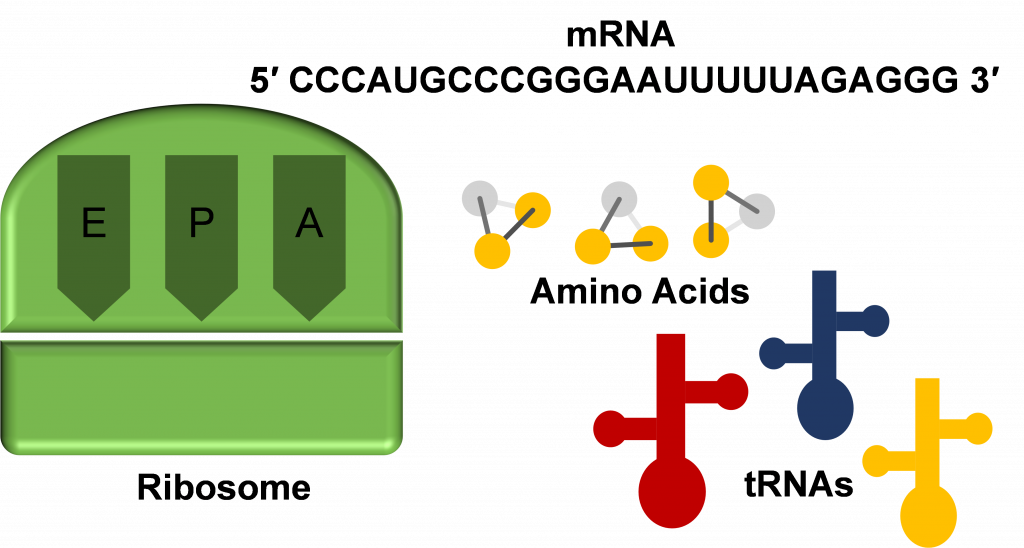
The tRNAs shown in Figure 6 are not ready for translation. The structure of the tRNA is recognized by special enzymes in the cell that attach the proper amino acid to the tRNAs. The tRNAs that are bound to their designated amino acid are called charged tRNAs (Figure 7). The near the middle of the 70-80 nucleotides in a tRNA are three nucleotides called the anticodon. When the tRNA folds, the anticodon becomes one end of the molecule and the other end will be attached to a specific amino acid. In the figures for this lesson, the tRNA is shown with its secondary structure and only the anticodon sequence is shown (Figure 7).
Let’s describe how the key players get protein building started, how they keep it going, and how they end it. Active ribosomes are assembled from small and large subunits when the ribosome “workbench” is ready to translate a mRNA (Figure 7). When mRNAs are present in the cytoplasm, the small and large ribosome subunits assemble at the 5’ end of these messages and are ready to read mRNAs like blueprints to build specific proteins.
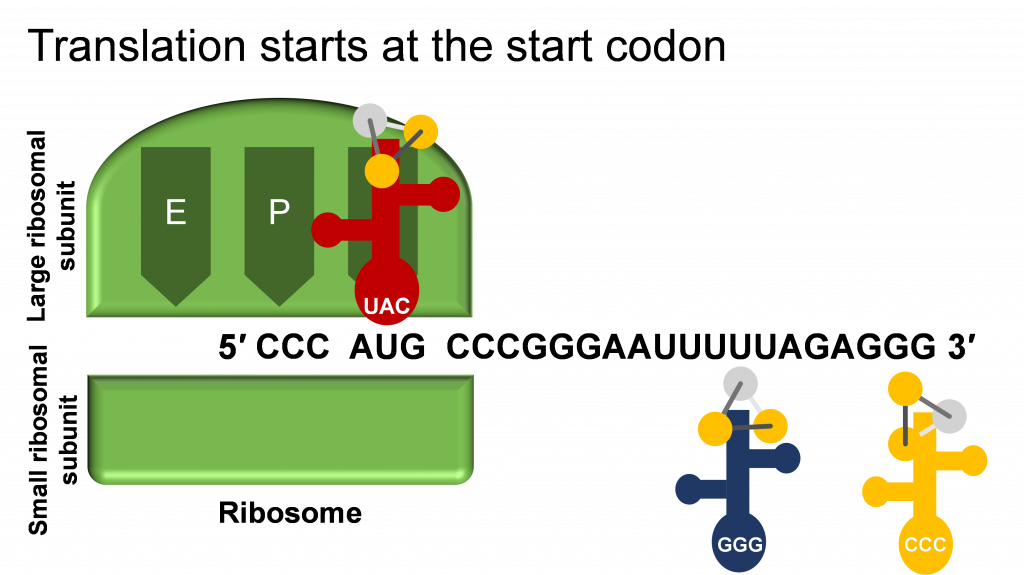
The ribosome reads the mRNA quickly and accurately, but it must determine where to start. As the ribosome moves in the 5’ to 3’ direction along the mRNA it “looks” for the sequence AUG (Figure 7). This sequence is called the start codon and signals the ribosome that this is where to begin building the protein sequence.
Watch this UNL video on Translation for more information about these processes.
The Reading Frame, Codons and Anticodons
The mRNAs, tRNAs, ribosomes, and amino acids are now in position to combine their specific functions into the building of a protein. The AUG start codon establishes the beginning of what is called a reading frame on a mRNA. The nucleotides in the mRNA must have the specificity to code for 20 different amino acids to build the protein. The genetic code is read as a three-letter code which provides this specificity. The ribosome will move along and read the sequence in the mRNA one codon (three nucleotides) at a time to follow the reading frame and build the correct protein (Figure 8).
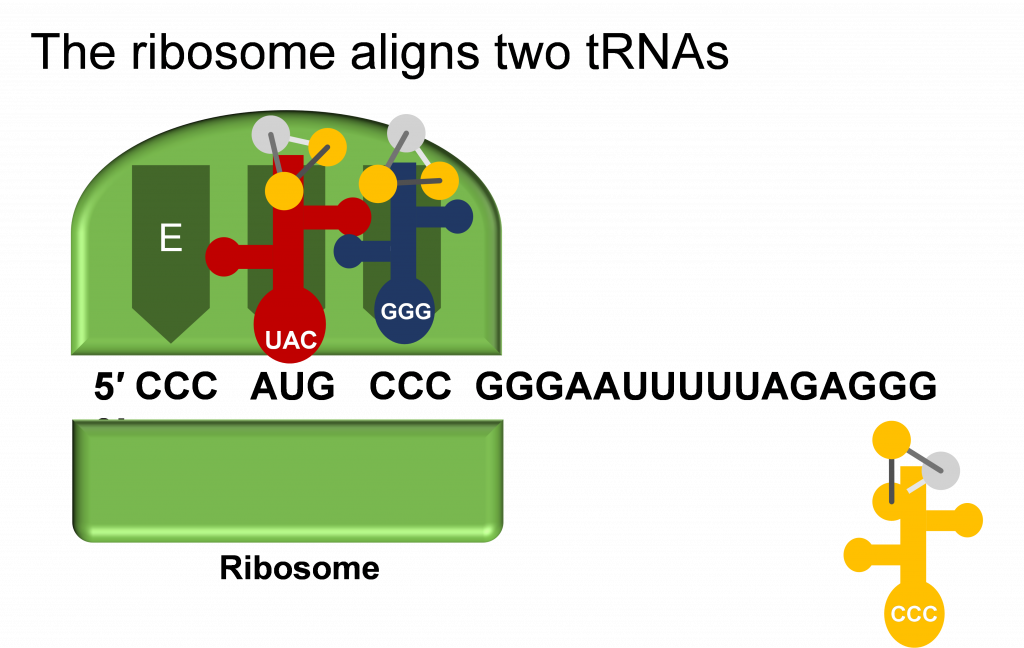
Getting Translation Started with the Start Codon
The AUG start codon signals the ribosome to place in the amino acid methionine. The A, P and E sites on the ribosome site works somewhat like a vice on the workbench, holding stuff in place so it can be worked on. In Figure 9, the ribosome has moved in the 5’ to 3’ direction on the mRNA .mRNA. This allowed a tRNA with the anticodon GGG to move into the A site and placed two amino acids very close to each other on the ribosome. The ribosome will now move one more codon in the 5’ to 3’ direction which moves the two tRNAs now to the E and P sites (Figure 9). Now the ribosome is ready to start binding together amino acids with peptide bonds to start to form a protein. A third tRNA (with the CCC anticodon) can now arrive at the open A site, bringing the amino acid designated by the GGG codon.
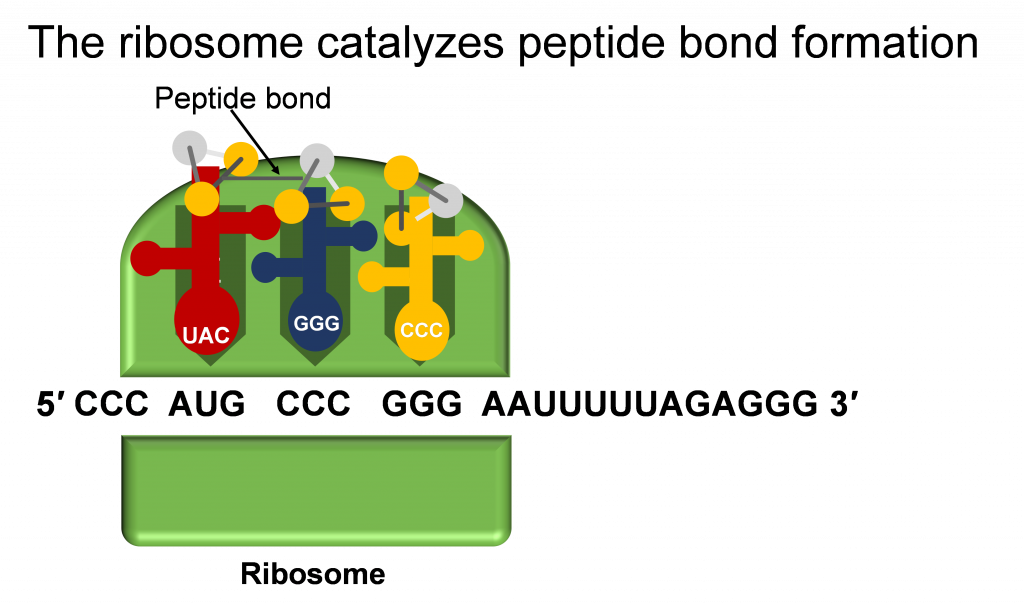
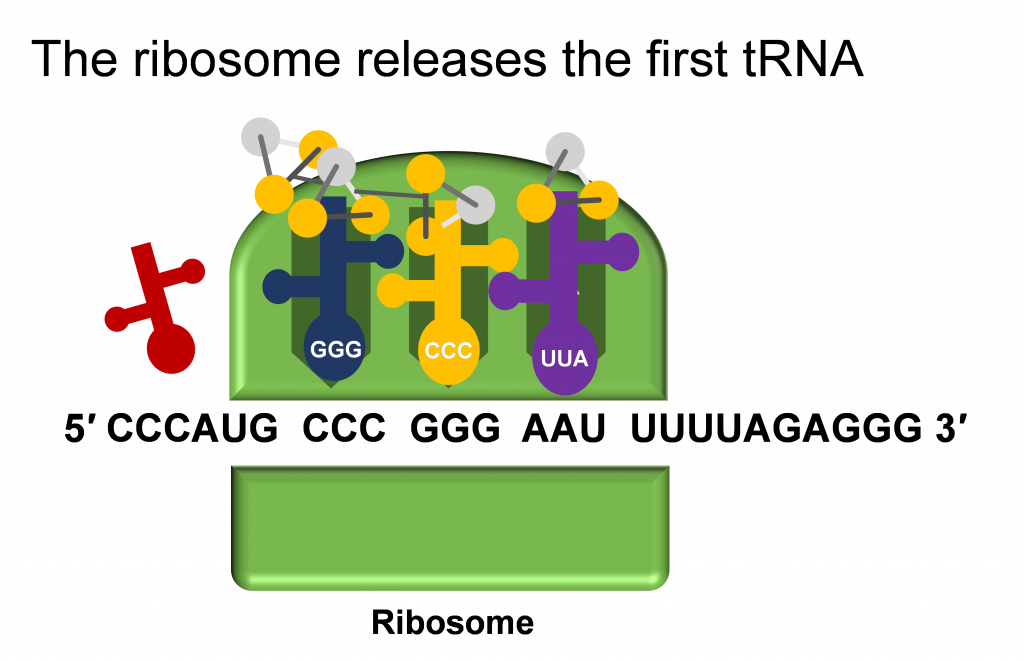
Peptide Bond Formation and Protein Building
As you can see, a ribosome “workbench” has catalytic tools to go along with its ‘P’ and ‘A’ “vice sites”. The ribosome has enzymatic functions that allow it to break and form bonds. The ribosome will break the bond that binds the amino acid to the tRNA at the ‘E’ site. Simultaneously the ribosome forms a peptide bond between the second and the third amino acids that were brought in by the tRNAs. The close proximity of these amino acids at the ribosome sites provides the opportunity for peptide bond formation and then release of the tRNA in a smooth continuous process (Figure 10 and 11). Peptide bonds always bind the acid end of one amino acid with the amino end of the next amino acid. Peptide bonds are strong covalent bonds which keep the amino acids connected during and after translation. The tRNA at the ‘E’ site has now accomplished its task by bringing in the first amino acid. This tRNA will then move off the ribosome (Figure 11). The tRNA released from a ribosome is recycled by the cell. It can be charged again by binding another amino acid in the cytoplasm and contribute to the synthesis of another protein. The protein. The first three amino acids in the protein have now been put together.
The synthesis of our protein is far from over. The ribosome continues to shift one codon in the 5’ to 3’ direction as a tRNA leaves the E site .site. A tRNA can now come into the A site if it has the anticodon that is complementary to the next codon on the mRNA. Proteins are hundreds of amino acids long. In our example, the steps described continue until the complete mRNA information is read to build the 667 amino acid long ALS enzyme.
The End of Translation: stop codons looking for something they cannot find

Start codons start translation so it is logical that stop codons stop translation (Figure 11) How do stop codons do this? There are 61 tRNAs with different anticodons (see Appendix 1: Codon Table). That means there are three codons that do not have corresponding tRNAs with complementary anticodons. These three codons serve as stop codons. When a ribosome encounters a stop codon on a mRNA it will wait for a tRNA with the right anticodon to come over. It will not skip the codon or shift over one nucleotide to form a new reading frame. The ribosome waits for the right tRNA, but it does not wait for long. A stalled ribosome will quickly cleave off the bound tRNA with the newly built protein chain and then move on to translate another mRNA. No tRNAs in the cell have anticodons that complement any of the three possible stop codons. Therefore, stop codons are able to end the translation process when the completed protein is made.
Sequence, structure, and function
In the case of our ALS protein, the assembly of all 667 amino acids into the polypeptide or protein chain in the correct order is important because the sequence of the amino acids determines how the protein folds. The folded structure of the protein determines its function. If some amino acids are changed and the structure changes, the ALS will not function properly as an enzyme in plant or microbe cells.
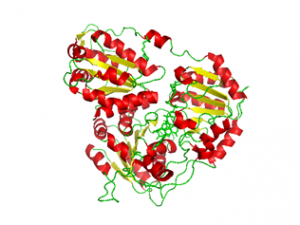
Organisms use the process of transcription to make mRNA as a temporary molecule to transport protein coding information from a gene. The translation process reads the mRNA and makes the intended protein, one amino acid at a time. This process is controlled by the promoter of the gene to ensure that proteins are made in the right cells at the right time to drive growth, development, metabolism, stress response and other processes needed to complete the organism’s life cycle.
Watch this video from UNL for an overview of Transcription and Translation.
Circle of Life and Gene Expression
Let us revisit the idea that gene expression works because living cells give rise to more living cells. Imagine yourself when you were just a single cell zygote with a copy of all the genes in the human genome from your biological mother and a copy from your biological father. What else did you need to get from your parents before you could express your first gene and build your first protein? You needed to already have an RNA polymerase in the nucleus of the cell to transcribe your first gene and you needed to have ribosomes, tRNAs and amino acids ready for translating that mRNA in the cytoplasm. Luckily, the egg cell from your mother had the 23 human chromosomes plus all of these gene expression biomolecules. Later, you could turn on your own genes for RNA polymerase, tRNAs and ribosomes but your mother’s egg cell was a living environment that allowed you to start your life.
A plant treated with a herbicide which binds to and blocks the action of the ALS enzyme likewise demonstrates that gene expression has a cycle of dependency on living cells. Small plants in an environment for rapid growth will have their growth halted by the ALS binding herbicides. The plants do not die from the herbicide, they just stop growing. The reason for this is that plants need to build new proteins to grow and to build new proteins they need the ALS enzyme to be working and building new leucine, isoleucine, and valine amino acids. ALS herbicide treated plants stop making these three amino acids and translation stops for every protein in the cell that requires at least one of these amino acids. Living things need amino acids to build proteins and plants and microbes need the ALS enzyme to build three of the amino acids. The next lesson (Gene expression part 2) will apply the gene expression principles from this lesson to the observation that some plants can be resistant to ALS inhibitor herbicides.

